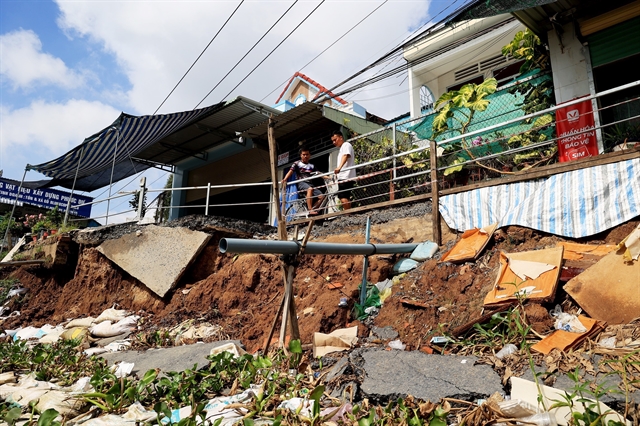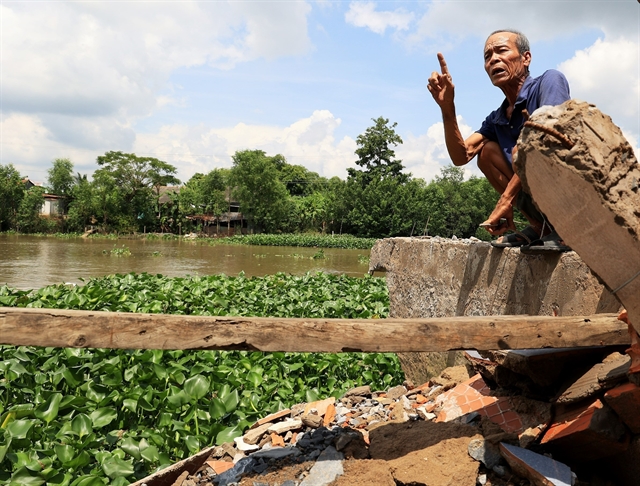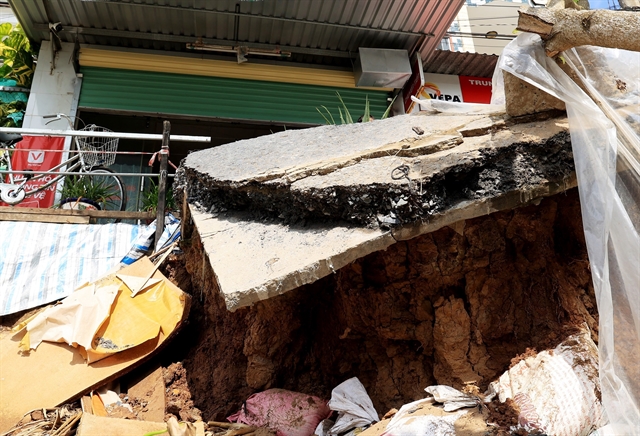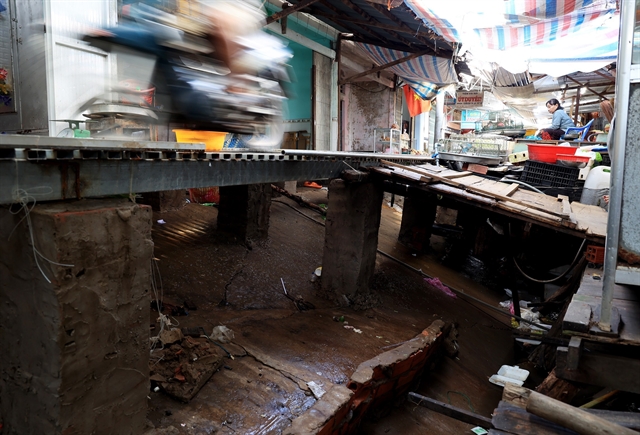 Society
Society


|
| People in the Mekong Delta region of Việt Nam are grappling with the impacts of erosion that have become rampant recently. — VNA/VNS Photo Hồng Đạt |
Hồng Đạt - Thanh Liêm - Nhựt An *
MEKONG DELTA — Never in her life has Lê Thị Sáu, a resident of Tân Phú Đông Commune lived in constant fear that her house might collapse anytime. But today she does.
Large cracks appearing in her yard, with some as long as 10m and wide as 20cm are signs of erosion getting so close, threatening the lives of the family of seven.
“Witnessing surrounding houses collapse scared me to death,” the 68-year-old living in Đồng Tháp Province said.
Sáu is among many people in the Mekong Delta region who are grappling with critical threats of rampant erosion that is caused by changes in rivers’ flow triggered by excessive sand mining and the construction of hydropower dams upstream that block sediment.

|
| Võ Văn Dũng, 73, saw his house collapse into Cần Lố River in Cao Lãnh District of Đồng Tháp Province due to erosion in May this year. — VNA/VNS Photo Hồng Đạt |
Living in constant fear
Feeling secure in their own homes is now a luxury that few people have in the Mekong Delta, a region already struggling with the immense pressure of climate change impacts.
Many in Tân Quới Commune don’t dare to sleep at night.
“The erosion was just terrible. When it happened, the soil collapsed, the boat parked nearby and the trees were pulled down and fell into the river,” said Đinh Tấn Phước, a local resident.
Sáu said she couldn’t sleep at night worrying about her four grandchildren living in her house.
The entire community in Tân Đông A Hamlet in Cà Mau Province’s Đầm Dơi District are feeling the brunt of erosions.
Bùi Thị Trúc, a merchant in Tân Tiến Market for a decade said the road passing through the market is sinking and becoming increasingly prone to erosions every year.
“Nowadays, we do business in fear, worrying that our properties and goods might fall into the river at any time.

|
| A concrete and asphalt is about to fall into the river due to erosion. — VNA/VNS Photo Hồng Đạt |
“For our livelihoods, we still have to cling here and live with fear!" Trúc said.
Erosion is also a big concern of Trang Thanh Lâm, who has been relying on a small bread stall in front of his house to feed the whole family for over ten years.
His house is located deep within the Tân Tiến Market and close to the banks of the Bọng Két River, with the rear of the house now sinking and lower than the front. During the day, when the water level rises, it reaches the floor of the house. Every time a boat passes by, the waves hit Lâm’s property.
Lâm said his family is surrounded by erosion.
“The back of my house already sank. The front and the road in front of it are also affected by erosions.
He said he was deeply concerned about the safety of the family.
Without money to repair the damage, Lâm said he has no other choice but to continue the daily struggle and live with the constant threat of erosion.
Đầm Dơi District is the hardest hit in Cà Mau Province. In the first half of this year, 129 out of 133 natural disasters occurring in the district were from riverbank erosions, damaging more than 200 metres of concrete embankment; collapsing 22 houses; damaging nine houses, 3,000 sq metres of forest land and nearly 2.3 km of roads. The total property damage is about VNĐ8 billion.
In Tân Tiến Commune, the most serious erosion area of Đầm Dơi District, a 500m-long road running through Tân Tiến market has been almost submerged into the river with many sections broken. Houses in the neighbourhood are always at risk.
Trần Bình Nhiều, a local resident said, last year the district invested in a temporary iron bridge here to make travel a bit easier for locals and merchants.
However when it rains, the bridge floor becomes slippery, causing many motorbikes and people to slip and fall, sometimes they crash into people's houses and shops.
Living in the Tân Tiến market area for more than half a century, Nguyễn Thị Hồng Nhánh said, when the erosion season comes, locals have to spend tens of millions of đồng to strengthen their houses. Many households were severely damaged and inundated due to high tide. Many couldn’t afford the repair of houses and had to migrate to other places.

|
| A temporary bridge is built at Tân Tiến market. — VNA/VNS Photo Hồng Đạt |
More severe
There has been a surge in erosion in the Mekong Delta region this year, according to official data.
In Vĩnh Long Province, there have been 80 erosions reported in the first six months of this year, making 2,404 metres of river bank disappear (up 1,800m), affecting 79 households and caused property damage of VNĐ7 billion, 10 times last year’s figure.
The southernmost province of Cà Mau is the hardest hit and the most vulnerable to erosion partly for its weak geology and strong flow.
So far, erosions in the province have covered more than 360km, causing damage to hundreds of houses and transport infrastructure projects. The total cost of property damage is estimated to be nearly VNĐ1.1 trillion.
This year, erosions are occurring at alarming levels. In most districts of Cà Mau, the number of erosions increased many times compared to previous years. — VNS
* This is part of a four-episode series by Vietnam News Agency reporters on erosions in the Mekong Delta region.




